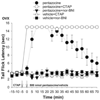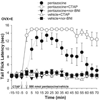Estrogen facilitates and the kappa and mu opioid receptors mediate antinociception produced by intrathecal (-)-pentazocine in female rats
- PMID: 27312267
- PMCID: PMC5120879
- DOI: 10.1016/j.bbr.2016.06.019
Estrogen facilitates and the kappa and mu opioid receptors mediate antinociception produced by intrathecal (-)-pentazocine in female rats
Abstract
Pentazocine, a mixed-action kappa opioid receptor (KOR) agonist, has high affinity for both KOR and the mu opioid receptor (MOR), and has been shown clinically to alleviate pain with a pronounced effect in women. However, whether local application of pentazocine in the spinal cord produces antinociception and the contribution of spinal KOR and MOR in mediating the effect of pentazocine in female rats remain unknown. Also, it is not known whether pentazocine-induced antinociception in females is estrogen-dependent. Hence, we investigated whether intrathecal (i.t.) (-)-pentazocine produces thermal antinociception and whether estrogen modulates the drug effect in female rats. Only the highest dose of pentazocine (500 nmol) was effective in producing antinociception in ovariectomized (OVX) rats. In contrast, pentazocine produced antinociception in estradiol-treated ovariectomized females (OVX+E) rats with the lowest effective dose being 250nmol. KOR or MOR mediated the effect of the lowest effective dose in OVX+E rats; however, MOR blockade extended the KOR-mediated effect of 500nmol pentazocine in both groups. In normally cycling females, the 250nmol dose was effective in producing antinociception at the proestrous, but not at the diestrous stage of the estrous cycle. Thus, estrogen facilitates and KOR or MOR mediates. the antinociceptive effect of i.t. (-)-pentazocine in female rats. Selective doses of (-)-pentazocine, with or without MOR blockade, may have a therapeutic benefit.
Keywords: Analgesia; Estrogen; Kappa opioid receptor (KOR); Mixed-action kappa opioid agonist; Mu opioid receptor (MOR); Spinal cord.
Copyright © 2016 Elsevier B.V. All rights reserved.
Conflict of interest statement
The authors do not have a conflict of interest involving this work.
Figures






References
-
- Mogil JS. Sex differences in pain and pain inhibition: multiple explanations of a controversial phenomenon. Nature reviews. Neuroscience. 2012;13(12):859–866. - PubMed
-
- Unruh AM. Gender variations in clinical pain experience. Pain. 1996;65(2–3):123–167. - PubMed
-
- Von Korff M, Dworkin SF, Le Resche L, Kruger A. An epidemiologic comparison of pain complaints. Pain. 1988;32(2):173–183. - PubMed
-
- Greenspan JD, Craft RM, LeResche L, Arendt-Nielsen L, Berkley KJ, Fillingim RB, Gold MS, Holdcroft A, Lautenbacher S, Mayer EA, Mogil JS, Murphy AZ, Traub RJ. G. Consensus Working Group of the Sex, S.I.G.o.t.I. Pain, Studying sex and gender differences in pain and analgesia: a consensus report. Pain. 2007;132(Suppl 1):S26–S45. - PMC - PubMed
Publication types
MeSH terms
Substances
Grants and funding
LinkOut - more resources
Full Text Sources
Other Literature Sources
Research Materials

